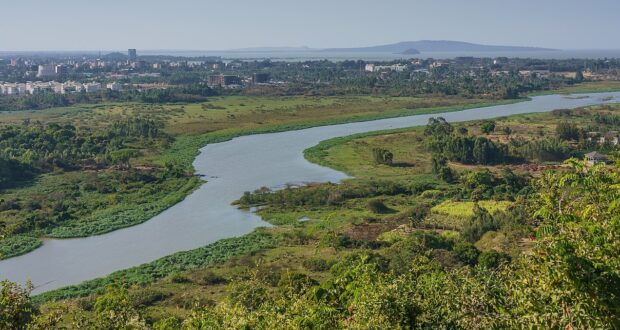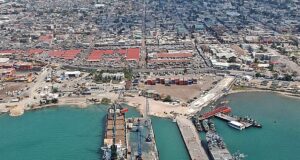18 February, 2021
By Jack Davies – Junior Fellow
With water scarcity in some highly populated regions projected to increase over the coming decades, some have argued that wars over access to and control of water may become some of the most common, most devastating conflicts of the 21st century.
Climate change impacts water more than any other natural resource, with the hydrologic cycle of evaporation, condensation, and precipitation that provides the fresh water rains which feed rivers and sustain life on land already beginning to be disrupted. Rising regional temperatures are increasing the volume of water which is lost from the world’s rivers and lakes each year to evaporation, droughts are becoming deeper and more sustained, and all the while human demand for fresh water is ever increasing.
The World Resources Institute (WRI) Global Water Risk Atlas categorises states by water stress – the ratio between use (household, agricultural and industrial) and available renewable supplies. Where usage exceeds 40% of supplies a state is considered at ‘high’ risk, with 80% corresponding to ‘extremely high’ risks. At these levels of demand states are extremely vulnerable to even small disruptions in supply. The Atlas lists much of Southern Europe, North Africa, the Middle East and South Asia as at high risk or above, identifying 17 states, home to a quarter of the world’s population, that face an extremely high risk.
In 2018, Cape Town became the first modern major city to face the real prospect of completely running out of water, avoiding this scenario, dubbed ‘Day Zero’, only after introducing major water usage restrictions. The following year Chennai, India’s sixth-largest city, experienced its own Day Zero after all four of its major reservoirs ran dry, leaving the city dependent on imported fresh water. Cape Town and Chennai are hardly the only cities at risk – in fact as many as one in four of the world’s major cities are facing severe water scarcity, with the World Health Organization (WHO) estimating that by 2025 half of humanity will live in water-stressed regions.
Water scarcity drives competition between water consumers at every level of society. This is particularly pronounced at the local level, where individuals and communities dependent on a shrinking body of water for sustenance and livelihoods (e.g. through agricultural use or fishing) have a very direct and tangible awareness of the issue. Perhaps nowhere is the link between scarcity, loss of livelihood, increased competition and local, national and regional insecurity more clear than in the transboundary (cross-border) Lake Chad Basin.
Nigeria, Chad, Niger, Cameroon and Lake Chad
The borders of four states, Nigeria, Chad, Niger and Cameroon meet one another in Lake Chad. Between 20 million and 30 million people live within the broader Lake Chad basin, which spans from Algeria in the north-west to the Central African Republic in the south-east; however, after a decade of conflict in the region against violent extremist organisations (VEO) including Boko Haram and Ansaru, an estimated 10.7 million of these are in need of humanitarian assistance, 2.8 million of whom are refugees. Water scarcity has both exacerbated and prolonged this conflict as well as driving instability directly by destroying livelihoods and displacing people.
Research by Saheed Babajide Owonikoko and Jude A. Momodu, both of Modibbo Adama University of Technology, Nigeria, found that over the last 60 years “climate change, over-exploitation and demographic pressure have contributed to the shrinking of [Lake Chad] by over 90%” from 25,000km2 to just 2,500km2. Aside from being a source of freshwater for drinking, sanitation and irrigation, the Lake also supports the livelihood of farmers, pastoralists, hunters and fishermen. Owonikoko and Momodu describe a cascade of negative consequences resulting from Lake Chad’s shrinking, with the subsequent loss of livelihoods promoting criminality, accelerating recruitment to VEOs, and driving migration away from the Lake toward urban centres.
Aside from the ongoing conflict between the Multinational Joint Task Force (MNJTF) (comprised of over 10,000 troops from each of the four Lake Chad states and nearby Benin) and Boko Haram, water scarcity and the subsequent loss of suitable agricultural land has greatly exacerbated violent conflict between herders and farmers in the region.
Additionally, while each of the four states have experienced some measure of reduction in the extent of the Lake within their borders, the loss has not been evenly distributed. Niger and Nigeria have each experienced a near total loss in volume as the bulk of the remaining water straddles the Cameroon-Chad border, forcing thousands of people to routinely cross national borders in order to reach the water. The result of this is that social, economic, environmental and political issues in the Basin have become inextricably bound up with one another, increasing suspicions between the states and damaging the ability of the MNJTF to effectively coordinate against Boko Haram.
However, while the shrinking of Lake Chad drives and exacerbates local and regional insecurity, it is unlikely to lead to open inter-state conflict between Nigeria, Chad, Niger and Cameroon. These states share the transboundary lake as a common water source, but none is totally dependent on it to sustain their broader population, and none have the ability to deny access to the other three outright. This is not always the case.
Egypt, Ethiopia and the Nile
Egypt is facing a catastrophic food and water security challenge, and at its centre is the transboundary Nile river. Egypt relies on the Nile for 97% of its water, with a steadily growing population on-track to hit almost 160 million in 2050 threatening to increase over-use and drive scarcity. Recent research has found that by 2030 between 20% and 40% of Egyptians will face water scarcity even during ‘normal years’, with that figure rising from 30% to 55% during the frequent hot and dry years predicted in the 2080s. Add to this Egypt’s struggling agricultural sector which, despite using 85% of Egypt’s share of the Nile, produces far short of demand, making Egypt highly reliant on food imports. Any major disruption of the Nile river would cause widespread water shortages, loss of agricultural land and rampant displacement, with Egypt’s minister of water resources and irrigation, Mohammed Abdel Aty, describing the situation as “an international security issue”.
Enter the Grand Ethiopian Renaissance Dam (GERD). Construction began on Africa’s largest hydroelectric power plant in 2011, with sufficient progress having been made by July 2020 for the Ethiopian government to begin filling the 74 billion cubic meter (bcm) reservoir during that year’s rainy season. GERD is situated on the Ethiopian Blue Nile, which meets the White Nile in Khartoum, Sudan, before flowing north through Egypt to the Mediterranean coast. The Blue Nile is responsible for roughly 85% of the Nile’s total flow, and with this hydroelectric potential in mind the GERD is expected to generate an annual output of 6000 megawatts, ample to not only supply all of Ethiopia’s energy needs but also to export power to a host of potential buyers in the region.
The potential downstream impacts of the GERD on the Egyptian Nile are alarming, but vary highly in their severity depending on how fast the reservoir is filled. If filled over a 21-year period GERD will cause a 5% reduction in water flow to Egypt, corresponding to a 3bcm reduction in the annual water budget and a 2.5% loss in agricultural area. The Ethiopian government, however, aims to fill the reservoir in as little as 5 years, resulting in a 36% water flow reduction, 20bcm reduction in the annual water budget and as much as 50% or 5 million acres of agricultural land lost in Egypt.
Disagreement over this proposed filling period, paired with concerns over what might happen in prolonged periods of drought, have left negotiations between Ethiopia, Egypt and Sudan (also highly reliant on the Nile) at an impasse. Broader discussions over each state’s share of the Nile have also made no progress, with Ethiopia’s offer of 35bcm per year falling far under Egypt’s current 55bcm allocation (as per colonial era treaties that notably excluded Ethiopia altogether). Apparently undeterred by the lack of agreement, the Ethiopian government have announced their intention to continue filling the GERD reservoir in 2021, planning to store 13.5bcm during this year’s rainy season.
Egypt has a lot to lose, and Ethiopia a lot to gain, but a conflict between the two over the Nile is not inevitable. For one thing, Egypt can draw on the 132bcm Lake Nasser reservoir formed by the Aswan High Dam to meet a fairly severe water deficit; however, the concern is that in crisis periods such as a multiple-year-long drought, Egypt, already facing a water scarcity crisis, may fully deplete its reservoirs. Without these reserves, Egypt may find itself dependent on Ethiopia releasing water held at the GERD reservoir, but Ethiopia, dependent on this water for the immense amount of power the GERD is intended to produce, might not be willing to release it in the quantities needed downstream.
In such a situation, absent of any prior agreements regarding how to manage the Nile’s water flow, Egypt may face a choice of either allowing millions of people to starve as agricultural land dries up and is lost, appeal to the international community, or compel Ethiopia to release water from its most important hydroelectric power plant, possibly by force. States go to war for a huge variety of reasons; it would seem that the ability to control the only real source of fresh water in one’s territory would be reasonably high on that list.
The impacts of water scarcity in Egypt would not necessarily be limited to a potential Egypt-Ethiopia conflict. If even 5% of Egypt’s 100 million person population were displaced, whether due to water scarcity itself or a potential conflict with Ethiopia, the eastern Mediterranean would be the site of another Syrian Civil War-scale refugee crisis. Given the Egyptian population’s extreme reliance on the Nile, this number in reality could be far higher. The potential influx of millions of refugees into water-rich Europe would potentially fundamentally transform European politics, either sparking unprecedented humanitarian efforts with renewed inter-state cooperation, or pushing Europe in a far-right nationalist direction (as was the case with the Syrian refugee crisis).
Prioritising Water
As our ability to shape the world around us continues to develop, and the critical need to scale-up renewable energy production becomes ever more widely recognised, it seems likely that large hydroelectric dams will be built on the world’s major rivers in ever-increasing numbers. Upstream development almost always has major consequences for downstream users, and in situations where a state is dependent on water sources originating in another state’s territory for the majority of its water needs, concern over access introduces a very real risk of escalation.
For states at risk, securing access to water is essentially an existential security issue, vital for meeting an ever-increasing demand for household, agricultural and industrial use. Conflicts arising from these pressure points could fast become some of the most geopolitically significant, strategically destabilizing, abjectly horrifying humanitarian disasters in history.
Yet, while it can drive insecurity and potentially even spark open conflict, water scarcity, particularly when it comes to transboundary rivers and lakes, can also provide a much needed incentive for cooperation. The shrinking Lake Chad is currently harming the capacity for regional coordination, yet it also provides opportunities for the states involved to come together to find technical, economic and political solutions that prioritise local communities. For example, accepting that reduced availability will continue to force people to cross national borders in search of water opens the door for multinational agreements to facilitate that movement.
Water scarcity is here to stay. Climate change and increasing demand will make it one of, if not the, most critical security and humanitarian concerns of the 21st century. Whether that leads to instability, conflict and disaster, or renewed cooperation and coordination depends on the decisions we make.
Image: Blue Nile River in Bahir Dar, Ethiopia (Source: A. Savin via Free Art Licence 1.3)
 Human Security Centre Human Rights and International Security Research
Human Security Centre Human Rights and International Security Research




